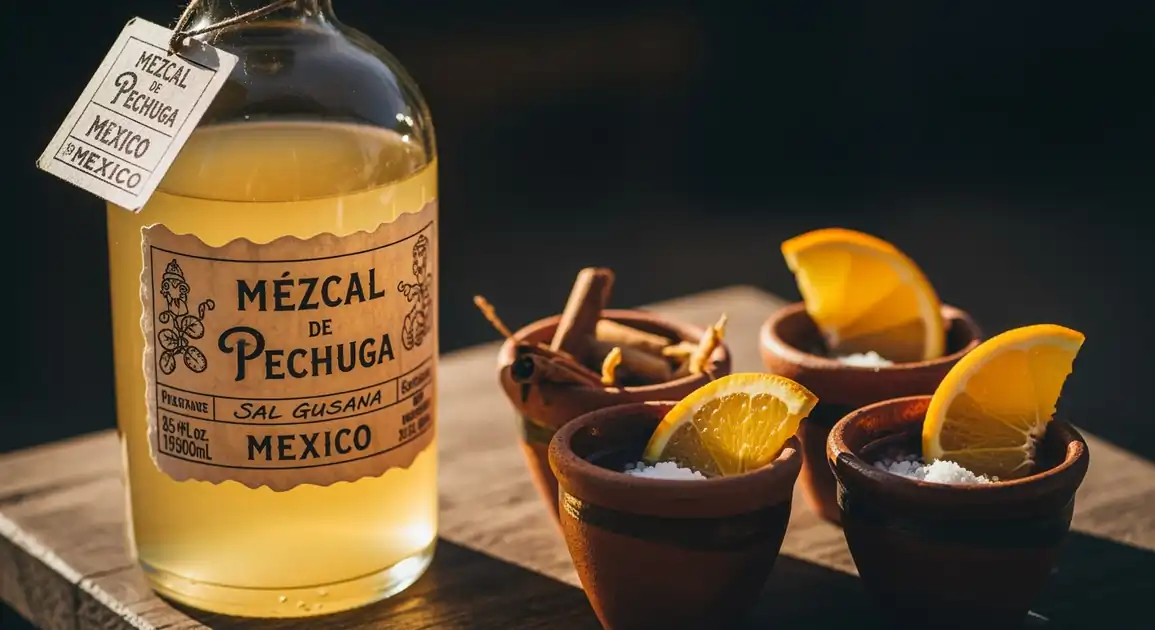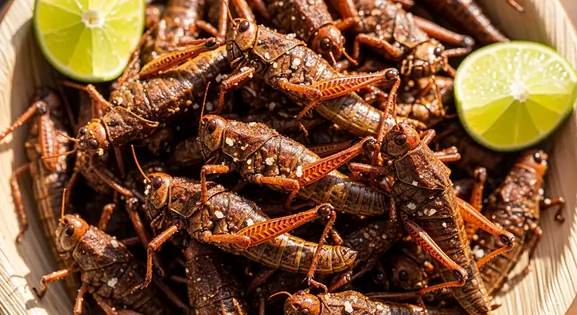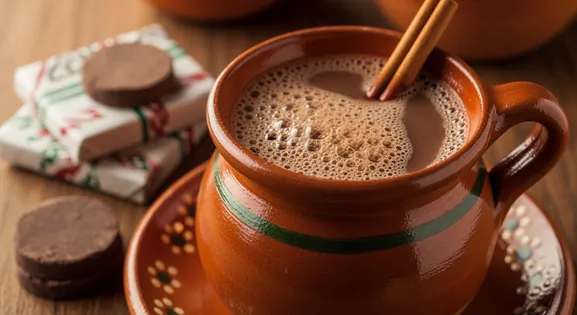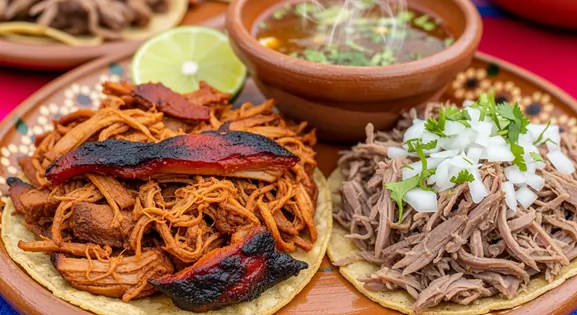Mezcal de Pechuga in Oaxaca
Mezcal de Pechuga

The Essential Guide to Mezcal de Pechuga
Stepping into Oaxaca, you quickly realize Mezcal de Pechuga is more than a drink; it's a cultural cornerstone. This ceremonial spirit, often reserved for special occasions, offers a profound taste of Oaxacan heritage. From bustling markets to serene palenques, finding authentic pechuga is an immersive journey into local traditions.
New to Mezcal de Pechuga? Learn all about its history in our complete guide.
Insider Tips for Mezcal de Pechuga
Take a day trip to Santiago Matatlán, the "World Capital of Mezcal," to visit a traditional palenque. Many offer tours and tastings directly from the producers.
Ask about "Pechuga de Temporada" (seasonal pechuga) which incorporates fruits abundant during specific times of the year, like mango or quince, offering unique flavor profiles.
Many high-end restaurants in Oaxaca City offer special tasting menus paired with different mezcals, including pechuga, providing a curated culinary experience.
Quality Checklist: How to Find the Best
What to Look For
-
Bottles from established 'palenques' or reputable 'mezcalerías' in Oaxaca City (e.g., around Centro Histórico) or known mezcal towns (Santiago Matatlán).
Authenticity and safety are higher when buying from known producers or specialized shops vs. random market stalls.
-
Detailed labels: Mention of 'Mezcal de Pechuga', specific agave type (often Espadín), 'maestro mezcalero', village of production, batch number, and NOM certification.
Oaxacan artisanal producers pride themselves on transparency. Lack of detail is suspicious.
-
Slightly higher price point compared to standard mezcal
The complex process justifies a higher cost (1500+ pesos). Unusually cheap 'pechuga' in tourist areas is likely fake or low quality.
-
Clear to slightly opalescent appearance, possibly with tiny sediment
Natural appearance for artisanal Oaxacan mezcal. Avoid artificially colored or perfectly filtered industrial products.
What to avoid
-
Unlabeled or poorly labeled bottles sold informally in markets or tourist shops
High risk of adulterated or unsafe spirits. Stick to sealed, properly labeled bottles.
-
'Pechuga' offered significantly cheaper than average market price
Likely not authentic or uses inferior ingredients/process. Quality pechuga is labor-intensive.
-
Vendors heavily marketing the 'chicken in the bottle' aspect
Authentic Oaxacan producers focus on the craft and tradition, not just the novelty of the meat infusion.
-
Tasting samples from communal, unlabeled jugs in tourist-heavy areas
Potential hygiene and authenticity concerns. Prefer tastings at dedicated 'mezcalerías' or 'palenques'.
A Traveler's Guide to Ordering Mezcal de Pechuga
When ordering Mezcal de Pechuga in Oaxaca, always ask for a small pour ("un caballito" or "una copita") to savor it slowly. Don't expect ice; it's traditionally served at room temperature. Many mezcalerías offer tasting flights, which are excellent for comparing different batches or producers before committing to a bottle. Engage with the mezcalero or bartender; they often share stories about the spirit's origin and the family behind it, enriching your experience. Remember, it's a spirit to be contemplated, not rushed.
A Guide to Finding Mezcal de Pechuga
Centro Histórico
Oaxaca City's historic center houses many specialized mezcalerías with carefully curated selections and knowledgeable staff.
Mezcaloteca, Expendio Tradición, El Destilado, In Situ Mezcalería
Evening (5 PM - 11 PM)
Santiago Matatlán
Known as the 'World Capital of Mezcal,' this town 45 minutes from Oaxaca City has the highest concentration of traditional palenques.
Numerous family palenques along the main road and side streets
Morning (10 AM - 2 PM), Afternoon (2 PM - 5 PM)
Miahuatlán Region
Further from the city but known for exceptional mezcal traditions and less commercialized palenques.
Small village palenques, Local weekly markets
Market days (varies by village), Morning to Early Afternoon (9 AM - 3 PM)
Mercado de Abastos
Oaxaca's main market has various stalls selling bottled mezcal, though quality varies significantly.
Dedicated liquor section of the market
Morning (9 AM - 1 PM), Afternoon (3 PM - 6 PM)
Vendor Tips
- Ask specifically about when the pechuga was produced – traditionally, it aligns with seasonal fruit availability.
- Request detailed information about all ingredients used in the third distillation.
- Many producers will show you their palenque's logbook with production details – this transparency indicates authenticity.
- Establish if they are the actual producer or a reseller – direct producer contact generally ensures better quality.
- Look for families with multiple generations of mezcalero tradition rather than new commercial operations.
The Traveler's Essentials
Dietary Information
Important Note for Travelers: Your safety is our priority. Below are the common allergens associated with the traditional preparation of this dish. However, recipes and ingredients can vary significantly between establishments. Always confirm all ingredients directly with the food vendor before ordering, especially if you have a severe allergy.
Potential Allergens
Dietary Suitability
Price Guide
Budget Tips
- Purchase directly from palenques in villages around Oaxaca City for better prices (700-2000 MXN) than tourist-oriented shops.
- At mezcalerías in Oaxaca City, tastings before purchase (150-300 MXN for a flight) let you compare before investing in a bottle.
- Village markets occasionally offer locally-produced pechuga at lower prices, but quality assessment requires knowledge.
- Bottles purchased directly from master mezcaleros during palenque tours often include personalized explanations and sometimes special batches not available elsewhere.
Serving & Seasonality
In Oaxaca, traditionally served in small clay copitas or jícaras (gourd cups) at room temperature. Never with ice. Usually accompanied by orange slices dusted with sal de gusano and sometimes local cheeses or chapulines (toasted grasshoppers) as traditional pairings.Best Times to Enjoy
- Late Afternoon: The traditional Oaxacan time for mezcal appreciation (4 PM - 7 PM), when work ends and social time begins.
- Evening: Commonly served during and after dinner hours at restaurants and mezcalerías (7 PM - 11 PM).
Seasonal Availability
While production often aligns with fruit harvests and cultural celebrations (particularly around Day of the Dead in November), quality examples are available year-round from established producers.
Local Significance
Local Significance
In Oaxaca, Mezcal de Pechuga transcends being merely a spirit – it embodies cultural heritage, community celebrations, and the connection between people and their environment. Many families have produced it for generations, with recipes and techniques forming part of their legacy. Traditionally reserved for significant life events, it carries deep ceremonial importance.
Eating Customs
- The traditional Oaxacan serving involves warming the copita in your hands before drinking.
- Before the first sip, some traditional drinkers whisper 'Stigibeu' – a Zapotec toast roughly meaning 'may the spirit move you.'
- Drinking is slow and contemplative – rushing is considered disrespectful to both the spirit and its maker.
- Some traditional settings involve passing a single copita among friends, each taking a small sip in turn.
Twists on a Classic
Central Valleys Style
Typically uses chicken breast with a balanced mix of seasonal fruits like apples, pineapple, bananas, and regional herbs. Generally considered the 'classic' style.
Sierra Sur Variation
Mountain regions often incorporate wild mountain fruits, berries, and sometimes pine nuts or herbs unique to higher elevations, creating more herbaceous profiles.
Miahuatlán Style
Known for using wild agaves like tobalá alongside the pechuga process, often with regional fruits specific to this southern region.
Thanksgiving Pechuga
A contemporary adaptation developed specifically for the North American market, using turkey breast and incorporating autumnal fruits and spices reminiscent of Thanksgiving flavors.
Practical Guides for Enjoying Mezcal de Pechuga
How to respectfully Taste Mezcal de Pechuga in Oaxaca
Understand the etiquette and process when sampling this ceremonial spirit.
- Visit a reputable 'mezcalería' in Oaxaca City or arrange a visit to a 'palenque' (distillery) in a mezcal region like Tlacolula or Matatlán.
- Express interest specifically in 'Pechuga'. Understand it's often seasonal (produced for holidays) and not always available.
- Listen respectfully as the host explains the specific fruits, nuts, spices, and meat used in that batch – Oaxacan ingredients vary widely.
- Sip slowly ('a besitos' - little kisses), don't shoot it. Appreciate the complex aroma and layers of flavor.
- Inquire about the 'maestro mezcalero' and the family tradition behind it. Showing interest in the craft is appreciated in Oaxaca.
Navigating Oaxaca Markets for Mezcal (and Pechuga)
Tips for buying mezcal safely and authentically in places like Mercado Benito Juárez or 20 de Noviembre.
- Prioritize established stalls within the market that specialize in mezcal, often run by families.
- Look for certified bottles (NOM number) even in markets. Be wary of unlabeled 'joven' mezcal passed off as something special.
- Ask specifically for 'Pechuga' but be prepared that authentic versions might not be openly displayed or available due to rarity/cost.
- Compare prices, but be suspicious of very low offers for Pechuga.
- If buying Pechuga, confirm the details on the label (agave type, maestro, village). Don't rely solely on verbal claims.
Our Commitment to Quality
At Tasteplorers, our mission is to provide the most accurate and useful travel information in the world. To achieve this, all content on this site is created through our unique editorial framework. We utilize leading AI research tools, guided by our proprietary prompts, and a multi-stage validation process. This entire system is overseen by our editorial team to ensure everything we publish meets our high standards for accuracy, cultural nuance, and practical value for travelers.
Learn more about our Editorial Process and our Mission.
Explore regions
Europe
Discover Europe's diverse culinary landscape, from Mediterranean flavors to hearty Alpine fare. Learn to navigate markets, decode menus, and eat like a local.
Latin America & Caribbean
Discover the vibrant cuisines of Latin America & the Caribbean. Our expert guide covers everything from Mexican street food to Peruvian ceviche and market tips.
Oceania
Explore Oceania's diverse food scene. Learn about Polynesian earth ovens, Fijian feasts, and the vibrant café culture of Australia and New Zealand.
Southeast Asia
Explore Southeast Asia's diverse food cultures from Thailand to Vietnam. Get expert tips on navigating spice levels, choosing quality vendors, and understanding the rich traditions of the region.



